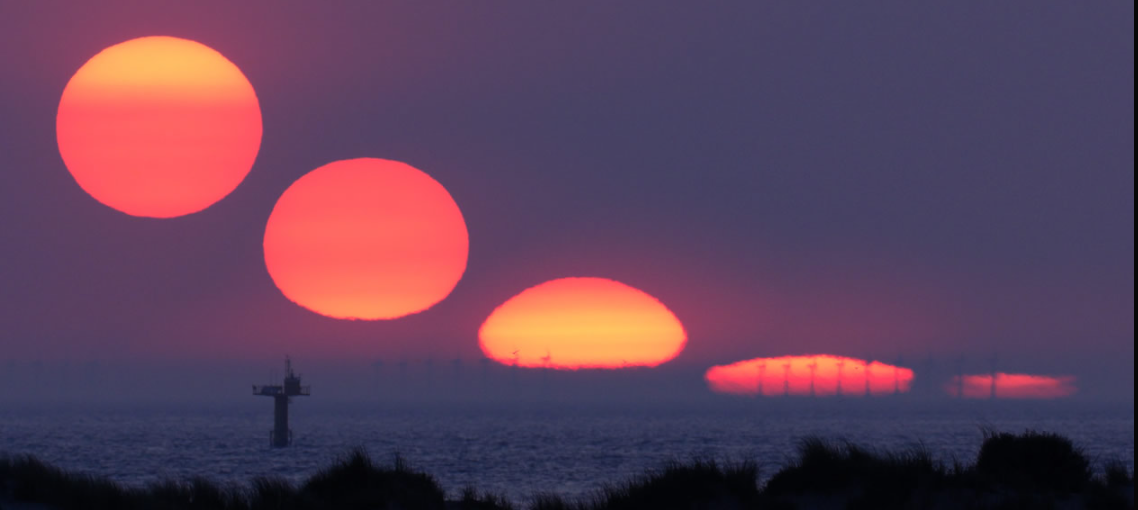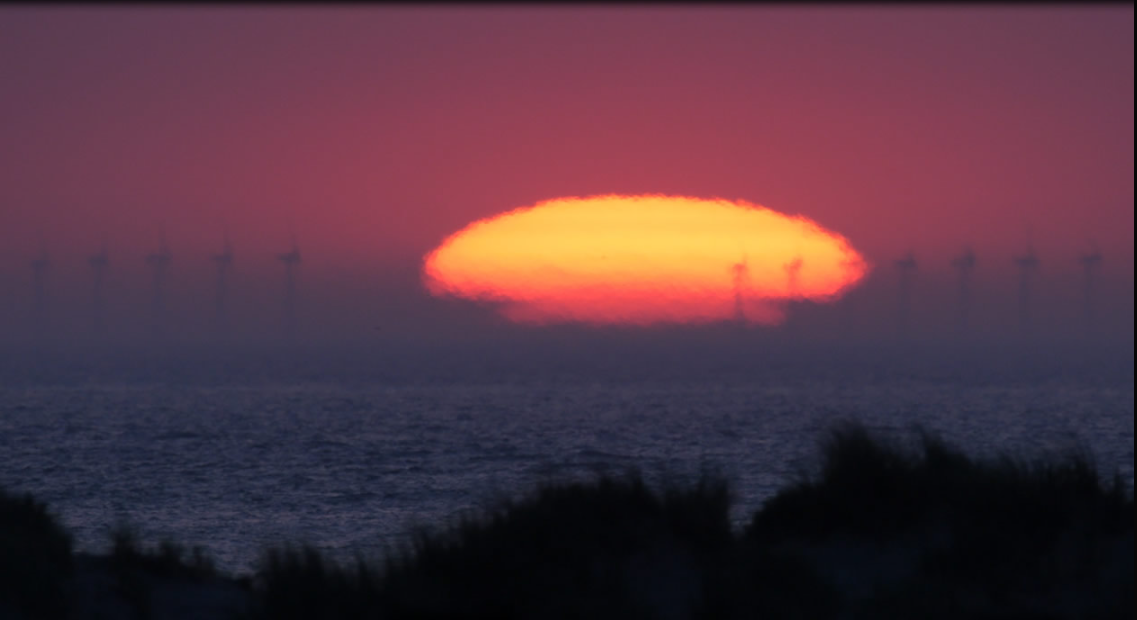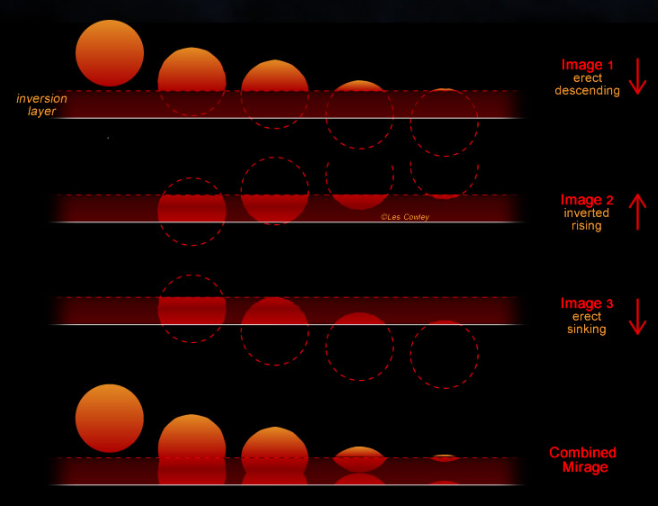Netherlands Spring Sunset - Refraction & Mirages - OPOD
Netherlands Spring Sunset: Exploring the Phenomena of Refraction and Mirages
When the warm wind blows over the cold North Sea during the spring season in the Netherlands, it creates a captivating atmospheric display during sunset. The interaction between cold and warm air layers leads to strong refraction and the formation of mirages. This mesmerizing phenomenon was beautifully captured by Michiel de Boer in a series of images, showcasing the stunning distortions and illusions that occur during this time.
Understanding Temperature Inversions and Mirage Formation
Temperature inversions occur when cooler air settles beneath warmer air. This creates unusual temperature and density gradients, which have a significant impact on the behavior of light as it passes through the atmosphere. During a spring sunset in the Netherlands, the almost horizontal rays of the setting sun refract at these temperature/density gradients, causing them to curve and appear to come from new directions.
The Illusion of Multiple Suns
As the sun begins to set, the mirage starts to take shape. The first sun, located above the inversion layer, appears to slide downwards. The layer itself seems to obscure the lower edge of the sun, creating the illusion of a false horizon. This image appears to be the "real" sunset, but there is more to come.
Within the inversion layer, a second sun emerges. This sun is entirely within the layer and is visible only as a slice. It is inverted compared to the actual sun and rises as the sunset progresses. The third image shows yet another sun within the layer, but this time it appears upright and sinks.
Unveiling the Mock-Mirage
The series of images captured by Michiel de Boer showcases what is known as a "3-sun mock-mirage." This phenomenon occurs due to the complex interplay between temperature inversions, refraction, and mirages. The mock-mirage is a visual distortion that creates the appearance of multiple suns, each with its own unique characteristics.
The Role of Turbulence and Wind Turbines
Turbulence between the layers of cold and warm air adds an additional layer of complexity to the sunset spectacle. As the warm wind blows over the cold North Sea, it creates ripples and disturbances within the lower limb of the sun. These turbulent movements contribute to the distortion and flattening of the sun's disk against the inversion layer.
In one of the images captured by Michiel de Boer, wind turbines are seen within the mirage. The serrated pie shape formed by the wind turbines adds a surreal element to the scene, further enhancing the captivating nature of the sunset display.
Appreciating the Beauty of Atmospheric Optics
The Netherlands Spring Sunset is a stunning example of the intricate and captivating nature of atmospheric optics. This phenomenon reminds us of the wonders that occur in our atmosphere and how they can create breathtaking illusions and distortions. By capturing these moments through photography, we gain a deeper appreciation for the beauty and complexity of the natural world around us.
Conclusion
The Netherlands Spring Sunset offers a fascinating glimpse into the world of refraction and mirages. The interplay between temperature inversions, refraction, and turbulence creates a visual spectacle that astounds and captivates viewers. Through the lens of Michiel de Boer's camera, we are transported to a realm where multiple suns appear in the sky, each with its own unique characteristics. This phenomenon serves as a reminder of the beauty and complexity of atmospheric optics, inviting us to marvel at the wonders that unfold above us.

Netherlands Spring Sunset
Montage by Michiel de Boer. A warm wind blows over the cold North Sea. Cold air layers beneath warmer, the stuff of strong refraction and mirages. First the disk distorts and flattens. Turbulence between the layers ripples its lower limb. The sun flattens more against the inversion layer. Then the mirage, a mock-mirage, starts. A pie shape serrated by wind turbines as a second sun appears within the inversion. All images ©Michiel de Boer, shown with permission.


The '3-sun mock-mirage'
The mirage forms during temperature inversions – unusually cooler air beneath warmer. Almost horizontal setting sun rays refract at the temperature/density gradients. They curve to appear to come from new directions.
The first sun, above the inversion layer, slides downwards. The layer appears to obscure the sun's lower edge giving the appearance of a sunset at a false horizon. This image seems to be the ‘real’ one but the second and third suns are no less real.
The second sun is wholly within the layer. We see just a slice. It is inverted. It rises as sunset progresses.
The third image , also within the layer, is upright and sinks.
Note: this article has been automatically converted from the old site and may not appear as intended. You can find the original article here.
Reference Atmospheric Optics
If you use any of the definitions, information, or data presented on Atmospheric Optics, please copy the link or reference below to properly credit us as the reference source. Thank you!
-
<a href="https://atoptics.co.uk/blog/netherlands-spring-sunset-refraction-mirages-opod/">Netherlands Spring Sunset - Refraction & Mirages - OPOD</a>
-
"Netherlands Spring Sunset - Refraction & Mirages - OPOD". Atmospheric Optics. Accessed on April 18, 2024. https://atoptics.co.uk/blog/netherlands-spring-sunset-refraction-mirages-opod/.
-
"Netherlands Spring Sunset - Refraction & Mirages - OPOD". Atmospheric Optics, https://atoptics.co.uk/blog/netherlands-spring-sunset-refraction-mirages-opod/. Accessed 18 April, 2024
-
Netherlands Spring Sunset - Refraction & Mirages - OPOD. Atmospheric Optics. Retrieved from https://atoptics.co.uk/blog/netherlands-spring-sunset-refraction-mirages-opod/.